期货期权期末考试复习必备
期货期末考试重点总结

期货期末考试重点总结一、期货基本知识概述1. 期货概念及特点:期货是一种标准化合约,合约买卖方约定在未来的某个日期、以约定价格和数量交割一定标的物的交易方式。
2. 期货交易的参与者:期货交易的参与者主要包括投资者、交易所、期货公司和期货经纪人等。
3. 期货合约的结算方式:期货合约可以进行实物交割或现金交割。
实物交割是指按照合约约定的标准,将标的物实际交付给买方。
现金交割是指按照合约约定的价格差额结算。
4. 期货价格形成机制:期货价格由供求关系决定,主要受到市场预期、供需关系和风险偏好等因素的影响。
5. 期货交易的风险管理:期货交易是一种高风险的投资方式,投资者应该了解和掌握风险管理方法,包括保证金制度、止损策略和期货套利等。
6. 期货交易策略:期货交易策略包括趋势跟踪策略、套利策略和交易系统等,投资者可以根据市场情况选择合适的交易策略。
二、期货市场的基本知识1. 期货交易所的分类:根据业务范围和交易品种的不同,期货交易所可以分为商品期货交易所和金融期货交易所。
2. 期货合约的分类:期货合约主要包括商品期货、金融期货和股指期货等。
3. 期货市场的交易方式:期货市场的交易方式主要分为开盘集合竞价交易和连续竞价交易。
4. 期货市场的交易规则:期货市场有一套严格的交易规则,包括市场开放规定、交易时间、交易手续费和交易细则等。
5. 期货交易的结算方式:期货交易的结算方式主要分为日内结算和隔夜结算两种。
三、期货交易的基本技术指标1. 即期价格与期货价格的关系:即期价格是指商品在市场上的现货价格,期货价格是指合约约定的将来交割的价格。
二者之间有着密切的关联性。
2. 期货市场的多空兴奋指标:多空兴奋指标是衡量投资者多头和空头的心理指标,可以通过市场的交易量和持仓量等数据进行分析。
3. 期货市场的成交量与持仓量分析:成交量和持仓量是市场的重要指标,可以用来判断市场的活跃程度和投资者的情绪。
4. 期货价格的交易日内走势分析:期货价格在交易日内会出现一定的波动,分析价格走势可以判断市场的走势和趋势。
期权期货期末复习资料

期权期货期末复习资料一、期权1. 期权的定义和基本特征期权是指在特定时间、特定价格买入或卖出一定量商品的权利。
期权的基本特征包括:行权价格、到期日、标的资产、权利金等。
2. 期权的类型和特点期权按行权方式可分为欧式期权和美式期权,按标的资产可分为股票期权和商品期权。
期权的特点包括:不对称性、杠杆效应、不确定性、灵活性。
3. 期权的定价模型期权的定价模型有黑-斯科尔斯模型、二叉树模型、蒙特卡罗模型等。
二、期货1. 期货的定义和基本特征期货是指在未来某一时间按照协议约定的价格买入或卖出一定数量的标的资产的合同。
期货的基本特征包括:标的资产、合约交割月份、合约交割方式等。
2. 期货交易和价格发现机制期货交易包括开仓、平仓、交割等环节,期货交易的价格发现机制包括报价和竞价两种方式。
3. 期货风险管理和投资策略期货风险管理包括价格风险管理和交割风险管理,投资策略包括套利策略、趋势跟踪策略、动态对冲策略等。
三、期权和期货的比较1. 相同点期权和期货都是衍生品,可以实现对标的资产的投资和风险管理。
2. 不同点期权是在未来以某个价格购买或卖出标的资产的权利,而期货是在未来按照协议约定的价格买入或卖出一定数量的标的资产的合同。
期权的风险和成本相对较低,但灵活性和杠杆效应较高,适合进行差价套利等策略;期货的杠杆效应相对较低,但成本和风险相对较高,适合进行风险对冲等策略。
四、结论期权和期货都是重要的金融工具,其基本特征和定价模型不同,适用于不同的投资策略和风险管理需求。
在实际投资中,应根据具体情况选择适合自己的工具和策略。
期权与期货期末复习【】

期权与期货期末复习【最新】本页仅作为文档页封面,使用时可以删除This document is for reference only-rar21year.March期权与期货期末复习一、单项选择题1、期货市场具有高收益、高风险的特点,原因在于(D )。
a、合约标准化b、商品现货交易c、每日无负债结算制度d、杠杆机制2、真正意义上的期货交易和期货市场开始形成的标志是(C )。
a、1848年,芝加哥的82位商人发起组建了芝加哥期货交易所b、1851年,芝加哥期货交易所引进了远期合同c、1925年,芝加哥期货交易所结算公司的成立d、1865年,芝加哥期货交易所推出标准化的合约3、期货合约的标准化是指除( B)外,期货合约的所有条款都是预先规定好的,具有标准化的特点。
a、交易品种b、价格c、交割要求d、最小变动价位4、( B)是我国第一个商品期货市场。
a、上海期货交易所b、郑州商品交易所c、大连商品交易所d、武汉商品交易所5、1975年10月,芝加哥期货交易所第一个推出(A)合约。
a.利率期货b.股指期货c.价值线综合指数d.外汇6、套期保值的目的是为了(D )。
a.获得实物商品b.获得金融商品c.消灭风险d.规避价格风险7、期货交易所交易的每手期货合约代表的标的商品的数量称为(D )。
a、合约名称b、最小变动价位c、报价单位d、交易单位8、如果交易商在最后交易日仍未将期货合约平仓,则必须(D )。
a、交付违约金b、强行平仓c、换成下一交割月份合约d、进行实物交割9、期货经纪公司应将客户所缴纳的保证金(A )a、存入期货经纪公司合同中指定的客户账户b、存入期货经纪公司在银行的账户c、存入期货经纪合同中所列的公司账户d、存入交易所在银行的账户10、在正向市场中,当客户在卖出套期保值时,如果基差值变大,在不考虑交易手续费的情况下,则客户将会( A)。
a、盈利b、亏损c、不变d、不一定二、多选题1、我国目前的期货交易所有( ABC)。
期权期货期末考考试题纲范围1级

பைடு நூலகம்看跌期出 权售资产的购 权买 利资产的义
期权价格
期权价格:即权利金,由内涵价值和时间价值构成。(内涵 价值是指立即履行期权合约时可获得的总利润。这是由期权 合约的执行价格与标的物价格的关系决定的。) 按照:执行期权所获得的收益情况的不同,期权可分为: 1、实值期权; 2、虚值期权; 3、平值期权。 期权的时间价值=期权价格-内涵价值
第二部分:期权市场
第十二章至第十七章
一、期权基础知识
期权定义
期权又称为选择权,是在期货的基础上产生的一种衍生性金融工 具。指在未来一定时期可以买卖的权利,是买方向卖方支付一定 数量的金额(指权利金)后拥有的在未来一段时间内(指美式期 权)或未来某一特定日期(指欧式期权)以事先规定好的价格 (指履约价格)向卖方购买或出售一定数量的特定标的物的权力, 但不负有必须买进或卖出的义务。 1973年,芝加哥期货交易所(CBOT)组建了芝加哥期权交易所 (CBOE),标志着以股票期权交易为代表的真正意义上的期权 交易开始进入了完全统一化、标准化以及管理规范化的全面发展 新阶段。
案例:股票期权的价值
给定期权的执行价格为55元,期权价值如下
304050607080 看涨期 0 权 0 0 5 1525 看跌期 25权 15 5 0 0 0
三、期权价值及其策略
看涨期权的价值
给定55元执行价格的看涨期权的价值.
-20元
盈亏平 衡点
55 75
买进看涨期权的运用
1、博取价差收益; 2、追逐杠杆效应; 3、限制交易风险; 4、保护标的物空头; 5、锁定现货成本;
期权的基本要素
1、交易单位 2、 最小变动价位 3、每日价格最大波动限制 4、执行价格间距 5、合约月份
期权期货期末复习资料(一)2024

期权期货期末复习资料(一)引言概述:期权和期货是金融市场中常见的衍生品,对投资者和交易员来说具有重要的意义。
期末复习资料(一)将带您深入了解期权和期货交易的基本概念和关键要点。
本文将分为五个主要部分进行阐述,每个部分涵盖五到九个小点,帮助您系统地复习期权和期货的知识。
正文:一、期权交易1. 什么是期权及其分类2. 期权交易的基本流程3. 期权交易的风险管理策略4. 期权定价模型和影响因素5. 常见的期权交易策略二、期货交易1. 什么是期货及其特点2. 期货交易的基本流程3. 期货交易的风险管理策略4. 期货合约的定价模型和影响因素5. 常见的期货交易策略三、期权与期货的区别和联系1. 期权与期货的定义和特点对比2. 期权与期货的交易机制对比3. 期权与期货的风险管理对比4. 期权与期货的定价模型对比5. 期权与期货的交易策略对比四、期权和期货市场的监管1. 期权和期货市场的监管机构2. 期权和期货市场的监管规定3. 监管对市场参与者和交易员的要求4. 监管对期权和期货市场的影响5. 监管对期权和期货投资者的保护措施五、期权和期货交易的实践应用1. 期权和期货在股票市场中的实际应用2. 期权和期货在商品市场中的实际应用3. 期权和期货在外汇市场中的实际应用4. 期权和期货在利率市场中的实际应用5. 期权和期货在风险管理中的实际应用总结:本文从期权交易、期货交易、期权与期货的区别和联系、市场监管以及实践应用等五个大点,详细阐述了期权和期货交易的相关知识。
期末复习资料(一)的内容涵盖了期权和期货的基本概念、交易流程、风险管理策略、定价模型和交易策略等关键要点,有助于读者全面理解期权和期货市场的运作机制。
复习本文的内容将帮助您对期末考试做好准备,提高对期权和期货交易的理解和应用能力。
期货期权考试复习资料
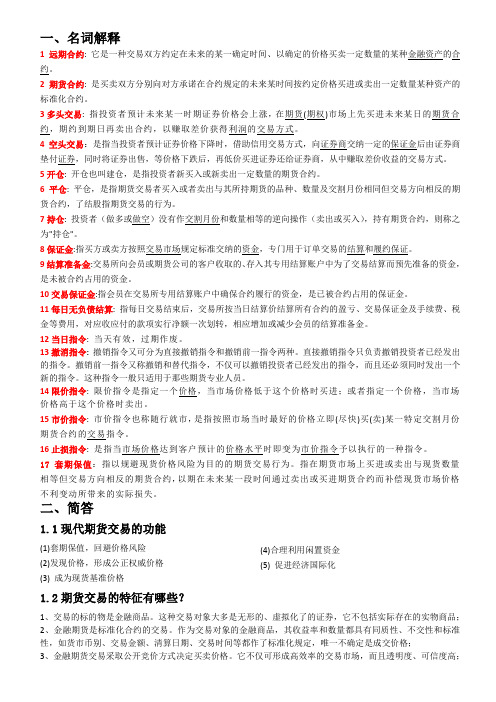
一、名词解释1远期合约: 它是一种交易双方约定在未来的某一确定时间、以确定的价格买卖一定数量的某种金融资产的合约。
2期货合约: 是买卖双方分别向对方承诺在合约规定的未来某时间按约定价格买进或卖出一定数量某种资产的标准化合约。
3多头交易: 指投资者预计未来某一时期证券价格会上涨,在期货(期权)市场上先买进未来某日的期货合约,期约到期日再卖出合约,以赚取差价获得利润的交易方式。
4空头交易:是指当投资者预计证券价格下降时,借助信用交易方式,向证券商交纳一定的保证金后由证券商垫付证券,同时将证券出售,等价格下跌后,再低价买进证券还给证券商,从中赚取差价收益的交易方式。
5开仓: 开仓也叫建仓,是指投资者新买入或新卖出一定数量的期货合约。
6平仓: 平仓,是指期货交易者买入或者卖出与其所持期货的品种、数量及交割月份相同但交易方向相反的期货合约,了结股指期货交易的行为。
7持仓: 投资者(做多或做空)没有作交割月份和数量相等的逆向操作(卖出或买入),持有期货合约,则称之为"持仓"。
8保证金:指买方或卖方按照交易市场规定标准交纳的资金,专门用于订单交易的结算和履约保证。
9结算准备金:交易所向会员或期货公司的客户收取的、存入其专用结算账户中为了交易结算而预先准备的资金,是未被合约占用的资金。
10交易保证金:指会员在交易所专用结算账户中确保合约履行的资金,是已被合约占用的保证金。
11每日无负债结算: 指每日交易结束后,交易所按当日结算价结算所有合约的盈亏、交易保证金及手续费、税金等费用,对应收应付的款项实行净额一次划转,相应增加或减少会员的结算准备金。
12当日指令: 当天有效,过期作废。
13撤消指令:撤销指令又可分为直接撤销指令和撤销前一指令两种。
直接撤销指令只负责撤销投资者已经发出的指令。
撤销前一指令又称撤销和替代指令,不仅可以撤销投资者已经发出的指令,而且还必须同时发出一个新的指令。
这种指令一般只适用于那些期货专业人员。
期货与期权期末考复习
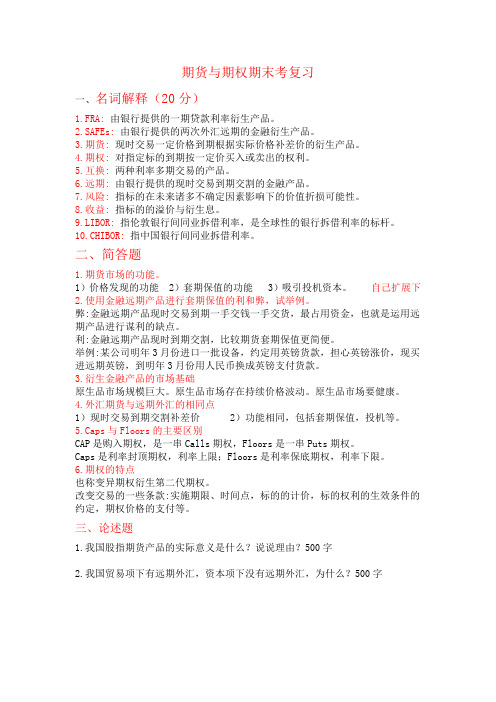
期货与期权期末考复习一、名词解释(20分)1.FRA: 由银行提供的一期贷款利率衍生产品。
2.SAFEs: 由银行提供的两次外汇远期的金融衍生产品。
3.期货: 现时交易一定价格到期根据实际价格补差价的衍生产品。
4.期权: 对指定标的到期按一定价买入或卖出的权利。
5.互换: 两种利率多期交易的产品。
6.远期: 由银行提供的现时交易到期交割的金融产品。
7.风险: 指标的在未来诸多不确定因素影响下的价值折损可能性。
8.收益: 指标的的溢价与衍生息。
9.LIBOR: 指伦敦银行间同业拆借利率,是全球性的银行拆借利率的标杆。
10.CHIBOR: 指中国银行间同业拆借利率。
二、简答题1.期货市场的功能。
1)价格发现的功能2)套期保值的功能 3)吸引投机资本。
自己扩展下2.使用金融远期产品进行套期保值的利和弊,试举例。
弊:金融远期产品现时交易到期一手交钱一手交货,最占用资金,也就是运用远期产品进行谋利的缺点。
利:金融远期产品现时到期交割,比较期货套期保值更简便。
举例:某公司明年3月份进口一批设备,约定用英镑货款,担心英镑涨价,现买进远期英镑,到明年3月份用人民币换成英镑支付货款。
3.衍生金融产品的市场基础原生品市场规模巨大。
原生品市场存在持续价格波动。
原生品市场要健康。
4.外汇期货与远期外汇的相同点1)现时交易到期交割补差价2)功能相同,包括套期保值,投机等。
5.Caps与Floors的主要区别CAP是购入期权,是一串Calls期权,Floors是一串Puts期权。
Caps是利率封顶期权,利率上限;Floors是利率保底期权,利率下限。
6.期权的特点也称变异期权衍生第二代期权。
改变交易的一些条款:实施期限、时间点,标的的计价,标的权利的生效条件的约定,期权价格的支付等。
三、论述题1.我国股指期货产品的实际意义是什么?说说理由?500字2.我国贸易项下有远期外汇,资本项下没有远期外汇,为什么?500字。
期货期权期末考试习题

期货期权期末考试习题期货与期权罗孝玲主编名词解释:1、套期保值:就是通过买卖期货合约来避免现货市场上相应实物商品交易的价格风险。
2、基差:是指在,某一时间、同一地点、同一品种的现货价格与期货价格之差。
3、套利交易:指的是在买入(卖出)某种期货合约的同时,卖出(买入)相关的数量相同的另一种期货合约,并在某个时间同时将两种期货合约平仓的交易。
4、期权:是指在某一限定时期内按事先约定的价格买进或者卖出某一特定金融产品或期货合约(统称标的资产)的权利。
(p212页)5、欧式期权:是指期权的购买方只有在期权合约期满日(即到期日)到来之时才能执行其权利,既不能提前,也不能推迟。
6、美式期权:是指期权购买方可于合约有效期内任何一天执行其权利的期权形式。
7、期货市场基本制度:保证金制度、平仓制度、持仓限额制度、大户报告制度。
强行平仓制度、信息披露制度。
P40到44页。
简答与比较题:1、期货交易与现货交易的区别。
P19页,答题的时候如果时间充分,是一个简答题的话就把每一点的下面那段话也抄上。
总共有5点。
2、期货交易与远期交易的区别。
P20页,最下方。
3、期货市场功能,P23页下面三点;期货交易所的职能,P25页共8点。
4、期权的特点:期权是一种权利的买卖;期权买方要获得这种权利就必须向卖方支付一定数额的费用;期权买方取得的权利是未来的;期权买方在未来买卖的标的资产是特定的;期权买方在未来买卖标的资产的价格是事先确定的;期权买方根据自己买进的合约可以买进标的资产或卖出标的资产。
5、套期保值需遵循的原则P63页。
计算题:1、书本第41页例题1,计算保证金的题目。
2、书本第57页例题2,计算实际盈亏和浮动盈亏的题型。
3、书本第62页例题1,讲的是买入套期保值的操作过程,与书本一样画一个表格,再把时间数据填写好,如果要分析的话就和书本一样,把数据变换一下就可以。
4、书本第64页例题2,讲的是卖出套期保值的操作过程,记得画表格。
期货期权期末考试试题

期货期权期末考试试题# 期货期权期末考试试题## 第一部分:选择题1. 期货合约的交易场所是:A. 银行B. 证券交易所C. 期货交易所D. 以上都不是2. 期权合约的买方拥有的权利是:A. 强制卖方履行合约B. 强制买方履行合约C. 选择是否履行合约D. 无权履行合约3. 期货合约的保证金类型不包括:A. 初始保证金B. 维持保证金C. 交易保证金D. 清算保证金4. 以下哪个不是期货交易的特点?A. 杠杆效应B. 标准化合约C. 现货交割D. 价格发现功能5. 期权的内在价值是指:A. 期权的市场价格B. 期权的执行价格C. 期权的执行价格与标的资产价格之差D. 期权合约的期限## 第二部分:简答题1. 简述期货合约与远期合约的区别。
2. 解释期权的时间价值,并举例说明其如何随时间变化。
3. 描述期货交易中的“逼仓”现象及其对市场的影响。
## 第三部分:计算题1. 假设你持有一份执行价格为50美元的看涨期权,标的资产的当前市场价格为60美元,期权的市场价格为5美元。
请计算该看涨期权的内在价值和时间价值。
2. 某投资者购买了一份期货合约,合约的初始保证金为5000美元,维持保证金为4000美元。
如果市场价格下跌导致保证金水平低于维持保证金,投资者需要追加多少保证金?## 第四部分:案例分析题某投资者预计未来三个月内,某商品的价格会上涨。
他决定购买期货合约来实现这一预期。
请分析以下两种策略的优缺点:A. 直接购买商品期货合约。
B. 购买看涨期权合约。
## 第五部分:论述题论述期货期权在风险管理中的作用及其在现代金融市场中的重要性。
请注意,以上内容仅为模拟试题,实际考试内容可能会有所不同。
考试时应仔细阅读题目要求,合理分配时间,确保答题的准确性和完整性。
祝你考试顺利!。
期权期货期末复习资料
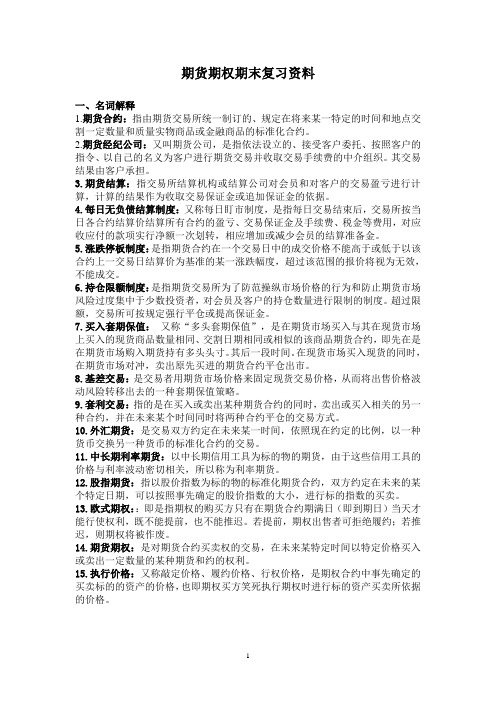
期货期权期末复习资料一、名词解释1.期货合约:指由期货交易所统一制订的、规定在将来某一特定的时间和地点交割一定数量和质量实物商品或金融商品的标准化合约。
2.期货经纪公司:又叫期货公司,是指依法设立的、接受客户委托、按照客户的指令、以自己的名义为客户进行期货交易并收取交易手续费的中介组织。
其交易结果由客户承担。
3.期货结算:指交易所结算机构或结算公司对会员和对客户的交易盈亏进行计算,计算的结果作为收取交易保证金或追加保证金的依据。
4.每日无负债结算制度:又称每日盯市制度,是指每日交易结束后,交易所按当日各合约结算价结算所有合约的盈亏、交易保证金及手续费、税金等费用,对应收应付的款项实行净额一次划转,相应增加或减少会员的结算准备金。
5.涨跌停板制度:是指期货合约在一个交易日中的成交价格不能高于或低于以该合约上一交易日结算价为基准的某一涨跌幅度,超过该范围的报价将视为无效,不能成交。
6.持仓限额制度:是指期货交易所为了防范操纵市场价格的行为和防止期货市场风险过度集中于少数投资者,对会员及客户的持仓数量进行限制的制度。
超过限额,交易所可按规定强行平仓或提高保证金。
7.买入套期保值:又称“多头套期保值”,是在期货市场买入与其在现货市场上买入的现货商品数量相同、交割日期相同或相似的该商品期货合约,即先在是在期货市场购入期货持有多头头寸。
其后一段时间。
在现货市场买入现货的同时,在期货市场对冲,卖出原先买进的期货合约平仓出市。
8.基差交易:是交易者用期货市场价格来固定现货交易价格,从而将出售价格波动风险转移出去的一种套期保值策略。
9.套利交易:指的是在买入或卖出某种期货合约的同时,卖出或买入相关的另一种合约,并在未来某个时间同时将两种合约平仓的交易方式。
10.外汇期货:是交易双方约定在未来某一时间,依照现在约定的比例,以一种货币交换另一种货币的标准化合约的交易。
11.中长期利率期货:以中长期信用工具为标的物的期货,由于这些信用工具的价格与利率波动密切相关,所以称为利率期货。
期货期权练习题答案
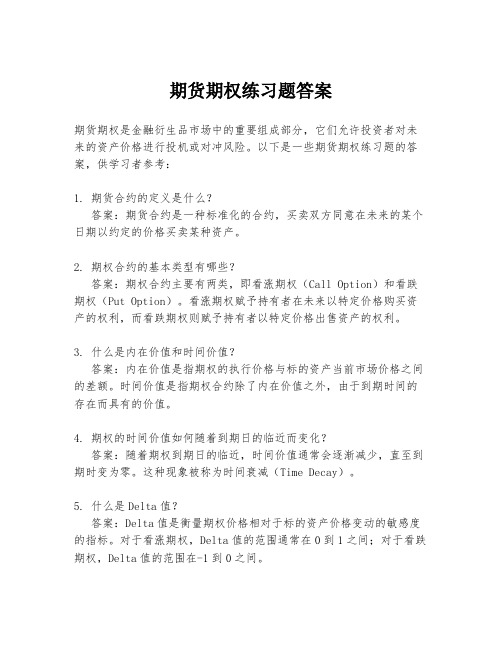
期货期权练习题答案期货期权是金融衍生品市场中的重要组成部分,它们允许投资者对未来的资产价格进行投机或对冲风险。
以下是一些期货期权练习题的答案,供学习者参考:1. 期货合约的定义是什么?答案:期货合约是一种标准化的合约,买卖双方同意在未来的某个日期以约定的价格买卖某种资产。
2. 期权合约的基本类型有哪些?答案:期权合约主要有两类,即看涨期权(Call Option)和看跌期权(Put Option)。
看涨期权赋予持有者在未来以特定价格购买资产的权利,而看跌期权则赋予持有者以特定价格出售资产的权利。
3. 什么是内在价值和时间价值?答案:内在价值是指期权的执行价格与标的资产当前市场价格之间的差额。
时间价值是指期权合约除了内在价值之外,由于到期时间的存在而具有的价值。
4. 期权的时间价值如何随着到期日的临近而变化?答案:随着期权到期日的临近,时间价值通常会逐渐减少,直至到期时变为零。
这种现象被称为时间衰减(Time Decay)。
5. 什么是Delta值?答案:Delta值是衡量期权价格相对于标的资产价格变动的敏感度的指标。
对于看涨期权,Delta值的范围通常在0到1之间;对于看跌期权,Delta值的范围在-1到0之间。
6. 如何计算期权的内在价值?答案:对于看涨期权,如果执行价格低于标的资产的市场价格,内在价值等于市场价格减去执行价格。
如果执行价格高于市场价格,则内在价值为零。
对于看跌期权,如果执行价格高于标的资产的市场价格,内在价值等于执行价格减去市场价格。
如果执行价格低于市场价格,则内在价值为零。
7. 期权的希腊字母有哪些,它们分别代表什么?答案:期权的希腊字母包括Delta、Gamma、Theta、Vega和Rho。
Delta衡量期权价格对标的资产价格变动的敏感度;Gamma衡量Delta 值对标的资产价格变动的敏感度;Theta衡量期权价格对时间流逝的敏感度;Vega衡量期权价格对标的资产波动率变动的敏感度;Rho衡量期权价格对无风险利率变动的敏感度。
期货与期权考试重点

名词解释●期货合约有交易双方在指定场所内按照相关规定达成的在将来某一确定时刻,按当前约定的价格,买卖某一确定资产的契约或协议●远期合约交易双方达成的在将来某一确定时刻,按双方现在达成协议确实定价格,买卖某一确定资产的契约或协议。
●期权是一种衍生性合约,即当合约买方付出期权费后,在特定时间内那么可向合约买方,依合约确定的价格买入或卖出一定数量确实定商品的权利●期货套期保值是以躲避现货价格波动风险为目的的期货交易行为●基差是指同时点上现货价格及对应期货价格之间的差额●正向市场期货价格高于现货市场,或者,远期月份期货价格高于近期月份期货价格。
●反向市场现货价格高于期货价格,或者,近期月份期货价格高于远期月份期货价格。
●基差交易是指以某月份的期货价格为计价根底,以该期货价格价格加减双方协商同意的基差来确定双方现货商品买卖价格的交易方式。
●利率期货合约是标的资产价格依附于利率水平的期货合约,即利率期货合约的标的物为利息率产品。
●转换因子是将交易所公布的标准债券期货价格的报价转换为特定债券报价的系数,即可使长期标准国债的价格及各种不同息票率及到期限期的可用于交割的国债的价格具有可比性的这算比率,是一种价格转换系数。
●跨式期权由具有一样执行价格、一样期限的一份看涨期权和一份看跌期权的构成的组合。
●投资性商品指投资者持有的、用于投资目的的商品简答一、期货合约及期权合约的关系期货合约由远期合约开展而来共同点:买卖双方约定于未来某一特定时间以约定价格买入或卖出特定的商品。
二、期货合约的设计原则三、期货市场的根本特征合约标准化、交易集中化、采取双向交易并具对冲机制、具有杠杆机制、采取逐日盯市结算四、期货市场的制度体系市场准入制度、每日无负债结算制度、保证金制度、持仓限额及大户报告制度、涨跌停板制度、强行平仓制度、信息披露制度五、期货市场组织的构造期货交易所、期货交易结算所、期货经纪公司、投资者及监管机构六、期货交易所的职能1.提供交易场所、设施及效劳3.设计期货合约,安排期货合约上市七、连续撮合竞价成交价格确实定买入价卖出价前一成交价,那么:最新成交价卖出价买入价前一成交价卖出价,那么最新成交价前一成交价前一成交价买入价卖出价,那么最新成交价买入价即,成交价为三者中居中的一个价格八、集合竞价确定原则最大成交量原则,即以此价格成交能够得到最大成交量;高于集合竞价产生价格的买入申报及低于该价格的卖出申报全部成交;等于集合竞价产生价格的买入或卖出申报,根据买入申报量和卖出申报量的多少,按少的一方的申报量成交;假设有两个价格以上符合上述条件,那么开盘价取及前一交易日结算价最近的价格。
期权考试题及答案

期权考试题及答案一、单项选择题(每题2分,共20分)1. 期权合约的标的资产可以是以下哪一项?A. 股票B. 债券C. 期货合约D. 以上都是答案:D2. 看涨期权赋予持有者什么权利?A. 以约定价格卖出标的资产的权利B. 以约定价格买入标的资产的权利C. 以市场价格买入标的资产的权利D. 以市场价格卖出标的资产的权利答案:B3. 期权的时间价值会随着到期日的临近而如何变化?A. 增加B. 减少C. 不变D. 先增加后减少答案:B4. 期权的内在价值是指什么?A. 期权的市场价格B. 期权的执行价格与市场价格之差C. 期权的执行价格与标的资产市场价格之差D. 期权的市场价格与执行价格之差答案:C5. 期权的杠杆效应是指什么?A. 期权价格对标的资产价格变动的敏感度B. 期权价格对标的资产价格变动的不敏感度C. 期权价格对标的资产价格变动的稳定性D. 期权价格对标的资产价格变动的不确定性答案:A6. 期权的到期日是指什么?A. 期权合约的开始交易日期B. 期权合约的最后交易日期C. 期权合约的执行日期D. 期权合约的到期结算日期答案:D7. 期权的行权价格是指什么?A. 期权合约的购买价格B. 期权合约的出售价格C. 期权合约的执行价格D. 期权合约的结算价格答案:C8. 期权的卖方在期权到期时必须履行什么义务?A. 买入标的资产的义务B. 卖出标的资产的义务C. 买入或卖出标的资产的义务D. 无义务答案:C9. 期权的买方在期权到期时可以行使什么权利?A. 买入标的资产的权利B. 卖出标的资产的权利C. 买入或卖出标的资产的权利D. 无权利答案:C10. 期权的平仓是指什么?A. 买入期权合约B. 卖出期权合约C. 买入和卖出相同期权合约D. 期权合约的到期结算答案:C二、多项选择题(每题3分,共15分)1. 以下哪些因素会影响期权的时间价值?A. 标的资产的波动性B. 期权的到期时间C. 期权的执行价格D. 无风险利率答案:A、B、D2. 期权的内在价值和时间价值之间的关系是什么?A. 内在价值和时间价值之和等于期权的市场价格B. 内在价值和时间价值之差等于期权的市场价格C. 内在价值和时间价值之和大于期权的市场价格D. 内在价值和时间价值之差小于期权的市场价格答案:A3. 以下哪些操作可以减少期权的时间价值损失?A. 选择波动性较低的标的资产B. 选择到期时间较短的期权C. 选择波动性较高的标的资产D. 选择到期时间较长的期权答案:A、B4. 期权的卖方在期权到期时可能面临的风险包括哪些?A. 无限亏损的风险B. 有限亏损的风险C. 无限盈利的风险D. 有限盈利的风险答案:A、D5. 期权的买方在期权到期时可能面临的风险包括哪些?A. 无限亏损的风险B. 有限亏损的风险C. 无限盈利的风险D. 有限盈利的风险答案:B、C三、判断题(每题1分,共10分)1. 期权的买方在期权到期时可以选择不行使期权。
期权与期货期末考试试题
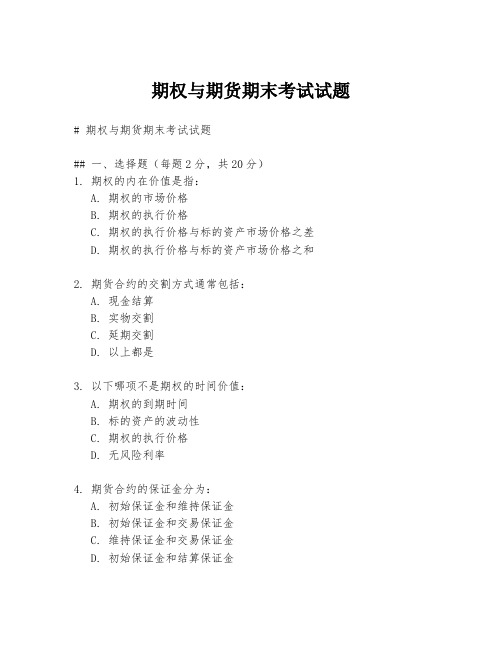
期权与期货期末考试试题# 期权与期货期末考试试题## 一、选择题(每题2分,共20分)1. 期权的内在价值是指:A. 期权的市场价格B. 期权的执行价格C. 期权的执行价格与标的资产市场价格之差D. 期权的执行价格与标的资产市场价格之和2. 期货合约的交割方式通常包括:A. 现金结算B. 实物交割C. 延期交割D. 以上都是3. 以下哪项不是期权的时间价值:A. 期权的到期时间B. 标的资产的波动性C. 期权的执行价格D. 无风险利率4. 期货合约的保证金分为:A. 初始保证金和维持保证金B. 初始保证金和交易保证金C. 维持保证金和交易保证金D. 初始保证金和结算保证金5. 期权的杠杆效应是指:A. 期权价格变动与标的资产价格变动的比率B. 期权价格与标的资产价格的比率C. 期权的内在价值与标的资产价格的比率D. 期权的执行价格与标的资产价格的比率## 二、简答题(每题10分,共20分)1. 简述期权与期货的主要区别。
2. 解释什么是看涨期权和看跌期权,并给出它们的基本特征。
## 三、计算题(每题15分,共30分)1. 假设你持有一份执行价格为50美元的看涨期权,标的资产的当前市场价格为60美元,无风险利率为5%,期权的到期时间为6个月。
请计算该期权的内在价值和时间价值。
2. 假设你购买了一份期货合约,合约规模为100单位,当前市场价格为每单位100美元,你需要支付的初始保证金为2000美元。
如果市场价格下跌到每单位90美元,你需要追加多少保证金?## 四、案例分析题(每题15分,共30分)1. 某投资者购买了一份看跌期权,执行价格为100美元,期权费为5美元。
当标的资产的市场价格下跌到90美元时,投资者选择行使期权。
请分析该投资者的盈亏情况。
2. 某公司预计未来需要购买大量原材料,为避免价格上涨,决定使用期货合约进行套期保值。
请分析该公司使用期货合约进行套期保值的优缺点。
## 五、论述题(15分)论述期权定价模型Black-Scholes模型的基本假设及其在实际应用中的局限性。
期货与期权期末考试

期货与期权期末考试一、引言期货和期权是衍生品市场中非常重要的两种金融工具,对于投资者和交易员来说具有重要的意义。
本篇文档将介绍期货和期权的基本概念、特点、交易方式、以及风险管理等内容。
对于期货与期权期末考试的准备将提供帮助。
二、期货的基本概念期货是一种标准化合约,约定在未来的某个时间点以特定价格进行买卖特定标的资产。
其特点包括交易标的物的标准化、买卖方向的对立性、定期结算等。
期货市场通常包括商品期货市场和金融期货市场。
2.1 商品期货市场商品期货市场是指以商品为标的资产进行交易的市场,主要包括农产品期货、能源商品期货和金属商品期货等。
例如,大豆、原油和黄金等都可以作为商品期货的标的物进行交易。
2.2 金融期货市场金融期货市场是指以金融资产为标的进行交易的市场,主要包括股票指数期货、利率期货和外汇期货等。
这些金融资产可以通过金融期货市场进行投资和套利操作。
三、期权的基本概念期权是一种赋予持有者权利但不强制要求其买卖标的资产的合约。
期权合约包括认购期权和认沽期权。
持有认购期权的人可以在未来的某个时间点以特定价格购买标的资产,而持有认沽期权的人可以在未来的某个时间点以特定价格卖出标的资产。
期权的特点包括灵活性、有限风险和杠杆效应。
期权市场主要包括个股期权市场和指数期权市场,可以为投资者提供丰富的投资机会。
四、期货和期权的交易方式期货和期权的交易方式有所不同。
4.1 期货交易方式期货交易通常发生在交易所中,交易流程包括开仓、平仓和交割等环节。
投资者可以通过交易所开设的期货账户进行交易,选择合适的交易品种和交易策略。
4.2 期权交易方式期权交易通常发生在交易所或场外市场中。
投资者可以选择购买或出售期权合约,根据自己的判断来获取收益或进行套利操作。
期权交易的流程包括选择期权合约、下单和执行等环节。
五、期货与期权的风险管理期货和期权的交易涉及一定风险。
风险管理是投资者必须注意的重要事项。
5.1 期货风险管理期货交易的风险主要包括市场风险、信用风险和操作风险。
期权考试题库及答案2024

期权考试题库及答案2024一、单项选择题(每题2分,共20分)1. 期权合约的买方拥有的权利是:A. 购买权B. 出售权C. 购买或出售权D. 无权答案:C2. 欧式期权只能在到期日执行,以下哪项描述正确?A. 正确B. 错误C. 无法确定D. 以上都不对答案:A3. 期权的时间价值随着到期日的临近而:A. 增加B. 减少C. 不变D. 先增加后减少答案:B4. 以下哪项不是期权的基本类型?A. 看涨期权B. 看跌期权C. 双向期权D. 以上都是答案:C5. 期权的内在价值是指:A. 期权的市场价格B. 期权的执行价格C. 期权的执行价格与标的资产市场价格之间的差额D. 期权的时间价值答案:C6. 期权的杠杆效应是指:A. 期权价格变动与标的资产价格变动的比率B. 期权的内在价值C. 期权的时间价值D. 期权的执行价格答案:A7. 期权的到期日是指:A. 期权合约的开始日期B. 期权合约的结束日期C. 期权合约的交割日期D. 期权合约的结算日期答案:B8. 期权的执行价格是指:A. 期权合约的购买价格B. 期权合约的出售价格C. 期权合约规定的标的资产交易价格D. 期权合约的市场价格答案:C9. 期权的卖方承担的义务是:A. 购买标的资产B. 出售标的资产C. 根据买方的选择购买或出售标的资产D. 无义务答案:C10. 期权的行权是指:A. 期权的购买B. 期权的出售C. 期权的执行D. 期权的放弃答案:C二、多项选择题(每题3分,共15分)1. 以下哪些因素会影响期权的价格?A. 标的资产价格B. 执行价格C. 到期时间D. 无风险利率答案:A, C, D2. 期权的时间价值受以下哪些因素影响?A. 标的资产的波动性B. 期权的执行价格C. 到期时间D. 无风险利率答案:A, C3. 以下哪些是期权的内在价值可能为零的情况?A. 看涨期权的执行价格等于标的资产市场价格B. 看跌期权的执行价格高于标的资产市场价格C. 看涨期权的执行价格低于标的资产市场价格D. 看跌期权的执行价格等于标的资产市场价格答案:A, B4. 以下哪些是期权的卖方需要考虑的风险?A. 标的资产价格的波动B. 期权的时间价值C. 期权的内在价值D. 期权的执行价格答案:A, C5. 以下哪些是期权的买方可能面临的风险?A. 期权的时间价值损失B. 期权的内在价值损失C. 期权的执行价格变动D. 标的资产价格的波动答案:A, D三、判断题(每题1分,共10分)1. 期权的买方在任何情况下都不会亏损超过支付的期权费。
期货期权期末复习资料
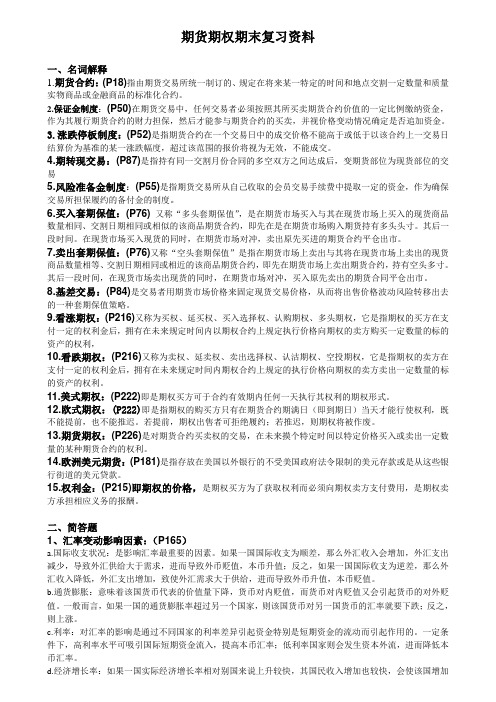
期货期权期末复习资料一、名词解释1.期货合约:(P18)指由期货交易所统一制订的、规定在将来某一特定的时间和地点交割一定数量和质量实物商品或金融商品的标准化合约。
2.保证金制度:(P50)在期货交易中,任何交易者必须按照其所买卖期货合约价值的一定比例缴纳资金,作为其履行期货合约的财力担保,然后才能参与期货合约的买卖,并视价格变动情况确定是否追加资金。
3.涨跌停板制度:(P52)是指期货合约在一个交易日中的成交价格不能高于或低于以该合约上一交易日结算价为基准的某一涨跌幅度,超过该范围的报价将视为无效,不能成交。
4.期转现交易:(P87)是指持有同一交割月份合同的多空双方之间达成后,变期货部位为现货部位的交易5.风险准备金制度:(P55)是指期货交易所从自己收取的会员交易手续费中提取一定的资金,作为确保交易所担保履约的备付金的制度。
6.买入套期保值:(P76)又称“多头套期保值”,是在期货市场买入与其在现货市场上买入的现货商品数量相同、交割日期相同或相似的该商品期货合约,即先在是在期货市场购入期货持有多头头寸。
其后一段时间。
在现货市场买入现货的同时,在期货市场对冲,卖出原先买进的期货合约平仓出市。
7.卖出套期保值:(P76)又称“空头套期保值”是指在期货市场上卖出与其将在现货市场上卖出的现货商品数量相等、交割日期相同或相近的该商品期货合约,即先在期货市场上卖出期货合约,持有空头多寸。
其后一段时间,在现货市场卖出现货的同时,在期货市场对冲,买入原先卖出的期货合同平仓出市。
8.基差交易:(P84)是交易者用期货市场价格来固定现货交易价格,从而将出售价格波动风险转移出去的一种套期保值策略。
9.看涨期权:(P216)又称为买权、延买权、买入选择权、认购期权、多头期权,它是指期权的买方在支付一定的权利金后,拥有在未来规定时间内以期权合约上规定执行价格向期权的卖方购买一定数量的标的资产的权利,10.看跌期权:(P216)又称为卖权、延卖权、卖出选择权、认沽期权、空投期权,它是指期权的卖方在支付一定的权利金后,拥有在未来规定时间内期权合约上规定的执行价格向期权的卖方卖出一定数量的标的资产的权利。
期权知识归纳及考试重点

重要考点:看涨期权与看跌期权的比较考频:★★ 内容要求把握,在脑子里形成印象,看到相关习题能有思路,不用刻意背诵。
期权类别 到期日价值损益 到期日价值的影响因素分析 看涨期权的执行净收入,称为看涨期权的看涨期权到期日价值,它等于 标的资产价格减去执看涨期权的损益,是指看涨期权的到期日价值减去期权费〔期(1) 在其他条件肯定的情形下,看涨期权的到期日价值,随标的资产价值上升而上升; (2) 在其他条件肯定的情形下,到期日一样的期权,执行价格越高, 看涨期权的到期日价值 就越低;行价格的差额。
权价格〕后的剩余。
〔3〕对于美式期权而言,在其他条件肯定的情形下,执行价格一样的期权,到期时间越长,看涨期权的到期日价值就越高。
看跌期权的执行净收入,称为看跌期权的看跌期权 到期日价值,它等于执行价格减去标的资产价格的差额。
看跌期权的损益,是指看跌期权的到期日价值减去期权费后的剩余。
(1) 在其他条件肯定的情形下,看跌期权的到期日价值,随标的资产价值下降而上升; (2) 在其他条件肯定的情形下,到期日一样的期权,执行价格越高, 看跌期权的到期日价值就越高; (3) 对于美式期权而言,在其他条件肯定的情形下,执行价格一样的期权,到期时间越长,看跌期权的到期日价值就越高。
重要考点:期权投资策略考频:★★ 内容要求把握,在脑子里形成印象,看到相关习题能有思路,不用刻意背诵。
(一)保护性看跌期权(二)抛补看涨期权(三)多头对敲 投资策略 含义 特点〔1〕假设股价高于执行价格,看跌期权毫无价值,损购进看跌期权与购多头对敲失了期权费,而看涨期权为实值被执行,执行的净收益进看涨期权的组合弥补看跌期权损失的期权费; 投资策略 含义 特点(1) 假设股价高于执行价格,则看涨期权被执行,期权净损失抵减股票投资收益;(2) 假设股价低于执行价格,则看涨期权不被执行,抛补看涨期 售出看涨期权与购则股价的下跌正好被看涨期权的净收益〔期权费〕所抵 权 进股票的组合 消。
- 1、下载文档前请自行甄别文档内容的完整性,平台不提供额外的编辑、内容补充、找答案等附加服务。
- 2、"仅部分预览"的文档,不可在线预览部分如存在完整性等问题,可反馈申请退款(可完整预览的文档不适用该条件!)。
- 3、如文档侵犯您的权益,请联系客服反馈,我们会尽快为您处理(人工客服工作时间:9:00-18:30)。
1.1 When a trader enters into a long forward contract, she is agreeing to buy the underlying asset for a certain price at a certain time in the future. When a trader enters into a short forward contract, she is agreeing to sell the underlying asset for a certain price at a certain time inthe future.1.2. A trader is hedging when she has an exposure to the price of an asset and takes a position in a derivative to offset the exposure. In a speculation the trader has no exposure to offset. She is betting on the future movements in the price of the asset. Arbitrage involves taking a position in two or more different markets to lock in a profit.1.3. In the first case the trader is obligated to buy the asset for $50. (The trader does not havea choice.) In the second case the trader has an option to buy the asset for $50. (The trader does not have to exercise the option.)1.4. The investor is obligated to sell pounds for 1.4000 when they are worth 1.3900. The gain is (1.4000-1.3900) ×100,000 = $1,000.The investor is obligated to sell pounds for 1.4000 when they are worth 1.4200. The loss is (1.4200-1.4000)×100,000 = $2,0001.5. You have sold a put option. You have agreed to buy 100 shares for $40 per share if the party on the other side of the contract chooses to exercise the right to sell for this price. The option will be exercised only when the price of stock is below $40. Suppose, for example, that the option is exercised when the price is $30. You have to buy at $40 shares that are worth $30; you lose $10 per share, or $1,000 in total. If the option is exercised when the price is $20, you lose $20 per share, or $2,000 in total. The worst that can happen is that the price of the stock declines to almost zero during the three-month period. This highly unlikely event would cost you $4,000. In return for the possible future losses, you receive the price of the option from the purchaser.1.6 One strategy would be to buy 200 shares. Another would be to buy 2,000 options. If the share price does well the second strategy will give rise to greater gains. For example, if the share price goes up to $40 you gain [2000($40$30)]$5800$14200,⨯--,=,from the second strategy and only 200($40$29)$2200⨯-=,from the first strategy. However, if the share price does badly, the second strategy gives greater losses. For example, if the share price goes down to $25, the first strategy leads to a loss of 200($29$25)$800⨯-=, whereas the second strategy leads to a loss of the whole $5,800 investment. This example shows that options contain built in leverage.1.7 The difference between Exchanges and Over-the-Counter Markets is that in an exchange markets buyers and sellers meet in one central location to conduct trades and in an over the counter market buyers and sellers in different location that are ready to buy or sell over the counter to any one who comes up and are willing to pay the price.1.9 An exchange-traded stock option provides no funds for the company. It is a security sold by one investor to another. The company is not involved. By contrast, a stock when it isfirst issued is sold by the company to investors and does provide funds for the company.1.10 If an investor has an exposure to the price of an asset, he or she can hedge with futures contracts. If the investor will gain when the price decreases and lose when the price increases, a long futures position will hedge the risk. If the investor will lose when the price decreases and gain when the price increases, a short futures position will hedge the risk. Thus either a long or a short futures position can be entered into for hedging purposes.If the investor has no exposure to the price of the underlying asset, entering into a futures contract is speculation. If the investor takes a lo ng position, he or she gains when the asset’s price increases and loses when it decreases. If the investor takes a short position, he or she loses when the asset’s price increases and gains when it decreases.1.11 he farmer can short 3 contracts that have 3 months to maturity. If the price of cattle falls, the gain on the futures contract will offset the loss on the sale of the cattle. If the price of cattle rises, the gain on the sales of the cattle will be offset by the loss on the futures contract. Using futures contracts to hedge has the advantage that it can at no cost reduce risk to almost zero. Its disadvantage is that farmer no longer gains from favourable movements in cattle prices.1.13. The holder of the option will gain if the price of the stock is above $52.50 in March. (This ignores the time value of money.) The option will be exercised if the price of the stock is above $50.00 in March. The profit as a function of the stock price is shown in Figure S1.1.1.14.The seller of the option will lose money if the price of the stock is below $56.00 in June.(This ignores the time value of money.) The option will be exercised if the price of the stock is below $60.00 in June. The profit as a function of the stock price is shown in Figure S1.2.1.16The trader makes a gain if the price of the stock is above $26 in December.1.18. The company could enter into a long forward contract to buy 1 million Canadian dollars in six months. This would have the effect of locking in an exchange rate equal to the current forward exchange rate. Alternatively the company could buy a call option giving it the right (but not the obligation) to purchase 1 million Canadian dollars at a certain exchange rate in six months. This would provide insurance against a strong Canadian dollar in six months while still allowing the company to benefit from a weak Canadian dollar at that time.1.19. The statement means that the gain (loss) to the party with the short position is equal to the loss (gain) to the party with the long position. In aggregate, the net gain to all parties is zero.1.20 The trader sells 100 million yen for $0.0080 per yen when the exchange rate is $0.0074 per yen. The gain is 10000006⨯. millions of dollars or $60,000.The trader sells 100 million yen for $0.0080 per yen when the exchange rate is $0.0091 per yen. The loss is 10000011⨯. millions of dollars or $110,000.1.22 A long position in four month but option can provide insurance against the exchange rate falling below the strike price . It ensures that the foreign currency can be sold at least the strike price.1.24 The arbitrageur should borrow money to buy a certain number of ounces of gold today and short forward contracts on the same number of ounces of gold for delivery in one year. This means that gold is purchased for $500 per ounce and sold for $700per ounce. Assuming the cost of borrowed funds is less than 20% per annum this generates a riskless profit.1.26 The investment in call options entails higher risks but can lead to higher returns. If the stock price stays at $94, an investor who buys call options loses $9,400 whereas an investor who buys shares neither gains nor loses anything. If the stock price rises to $120, the investor who buys call options gains2000(12095)940040600$⨯--=,An investor who buys shares gains100(12094)2600$⨯-=,The strategies are equally profitable if the stock price rises to a level, S , where100(94)2000(95)9400S S ⨯-=--or100S = The option strategy is therefore more profitable if the stock price rises above $100.1.28 The trader has a long European call option with strike price K and a short European put option with strike price K . Suppose the price of the underlying asset at the maturity of the option is T S . If T S K >, the call option is exercised by the investor and the put option expires worthless. The payoff from the portfolio is then T S K -. If T S K <, the call option expires worthless and the put option is exercised against the investor. The cost to the investor is T K S -. Alternatively we can say that the payoff to the investor in this case is T S K - (a negative amount). In all cases, the payoff is T S K -, the same as the payoff from the forward contract. The trader’s position is equivalent to a forward contract with delivery price K . Suppose that F is the forward price. If K F =, the forward contract that is created has zero value. Because the forward contract is equivalent to a long call and a short put, this shows that the price of a call equals the price of a put when the strike price is F .2.3 保证金账户最大的变动范围为($4000-$3000)=$1000,所以当银价格上涨到5.2+1000/5000= $ 5.4每盎司时,将收到保证金催付通知,如果没有及时补足保证金,合约将被强制平仓。
